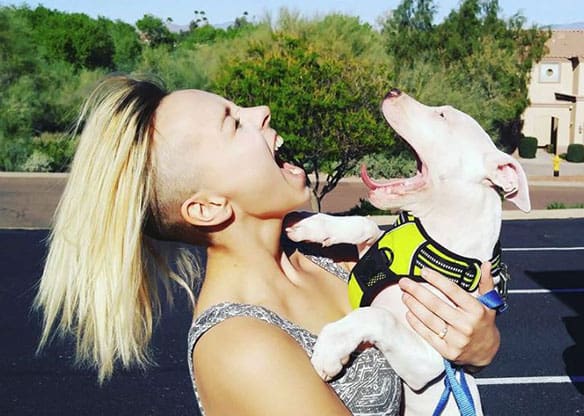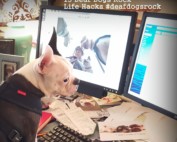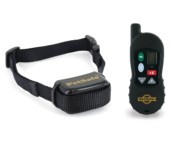Please welcome our guest blogger Bernard – Lima Chavez from Dog and His Boy Blog.
Old Dog and New Tricks by Bernard – Lima Chavez – www.DogandHisBoy.com
I’ve learned many virtues from our dogs, but the most important lessons have come from our deaf dog, Edison. Greed, gluttony, envy…oh, snap, I’ve confused vices and virtues again. My bad. Anyway, the first virtue on that list is patience. Teaching a deaf dog hand signals takes time and shouldn’t be rushed. Before Edison, the only proper hand signal I knew was best left for moments of road rage, so it took me a little longer than I expected.
If you’re new to this whole deaf dog thing, it’s important to know that you need to do some planning. First, you have decide what commands you want to teach. You then have to decide which signs you are going to use. Finally, you are going to have to stock up on treats and begin to practice. After you’ve practiced for a while and you know the signs pretty well, you can call the dog into the room (if you remember how).
For my husband and I, we made a list of twenty-five commands we were hoping to teach Edison over the course of his lifetime- a deaf dog bucket list, if you will. If we had taught him half of those signs, we would’ve been happy. By the time Edison was six months old, he knew more than fifteen of them and we expanded our list. I’m not sure if this qualifies him as gifted, but we were proud nonetheless.
The first commands we put on our list were basic obedience: sit, stay, come and, very important for deaf dogs, watch me. We felt that these needed to be the foundation for everything that followed. We needed to know that we could get him under control or away from danger before we tackled anything else. I work with all the deaf dogs at the Humane Society of Greater Miami, and I still begin with these four commands. My husband and I then added the things that were most important to us, things that we like to say to our dogs or activities they enjoy. Things like walk, cookie, hungry, potty, car ride and I love you. We also put no on that list and, to accommodate our nature as humans, we added quit as an escalation to an ignored No!
Bernard working with deaf dog Pearl.
To this day, we continue to teach. Once he learns a new sign, we go to the dog park, celebrate his victory with a picnic of peanut butter and rocks and then move on to the next command. When making your list, don’t be afraid to dream big. These extraordinarily special creatures are capable of awesome things; don’t sell them short. Go tell Papi to fix his own damn dinner may never happen in our house, but I’m giving it a shot anyway.
Once you’ve decided what commands to teach, you then have to learn the signs yourself. For me, this involved an American Sign Language (ASL) pocket dictionary, several online resources and practicing the signs we had chosen. I have a hectic schedule with very little mirror time, so much of my practice happened in my car or in line at Starbucks. You get used to the judgement of strangers, I promise, and if the barista is sitting on a particularly high horse that day, you can always practice Bad girl. Sit down. No more bark.
 Edison is treat motivated and focused on Bernard while they do daily consistent positive reinforcement mini-training sessions throughout the day.
Edison is treat motivated and focused on Bernard while they do daily consistent positive reinforcement mini-training sessions throughout the day.
For us, we decided to use as much ASL as possible. Though there are some very good reasons to use a standardized system, exceptions must be made sometimes. This is where deaf dog sign language comes in. You see, many ASL signs are two-handed, which is fine inside the house. However, when holding a leash, using two hands isn’t always practical or safe. Also, you can’t sign many ASL words correctly with something obstructing hand or finger placement and movement. Many people with deaf dogs find that it is more practical to modify a two-handed ASL sign or completely make one up. Collectively, these signs are known as DDSL: Deaf Dog Sign Language.
 Bernard giving Edison the “watch me” sign.
Bernard giving Edison the “watch me” sign.
So long as it works for you and your dog, it doesn’t matter what sign you choose; the important thing is consistency. If you’re inclined to do jumping jacks every time you want him to sit, knock yourself out. I wouldn’t recommend it, but hey, I’m not an expert and maybe that will work for you. If so, make sure you’re comfortable with more judgment from more strangers. Real comfortable. The point is, you can teach whatever signs you want, so long as you are consistent and humane in your teaching methods.
Once you have the sign down pat, you have to figure out a way to teach it to the little man. Positive reinforcement methods always work best. Be humane and never punish with your hands- with a deaf dog, all touch should be positive. Dee Hoult with Applause Your Paws was an invaluable resource for us. She also sits on the Board of Trustees of the Association of Professional Dog Trainers. There are a lot of websites with information on positive reinforcement. Do yourself and your dog a favor, look into it.
Edison is very food motivated, more so than by play or affection, so treats were our go-to reward. This also meant that I had to remember to keep a bottomless supply of treats at hand, and for someone who forgets that, in some circles, belching and flirting are two different things, this was an obstacle for me. Eventually, I learned to stash treats all over the house. I also kept a small container at the front door, near the hook where leashes and collars and harnesses hang. Over the days, weeks or months that the little man is learning a particular sign, you have to remember to use it consistently and correctly. You learn patience during this process. Go easy on yourself and your dog; you will both get it right, and there is nothing better than that unexpected moment when he responds correctly and gives you the right behavior, and you know that he knows. That is good day and one you will remember. I will never forget the day that Edison first responded to the sign for you hungry? When he licked his lips, I did my happy dance and yes, it involved some twerking.
One tip I learned is to make training in repetition a part of your daily routine. Every time you fill the water bowl, give the sign for water. Every time you get into the car, give the sign for car. Every time he pees on your mother, give him the thumbs up and a hot dog. This constant reinforcement will increase his vocabulary very quickly and painlessly. I never did intensive, dedicated training with some of these secondary signs the way I did with basic life skills, such as sit or stay, but he knows them just as well.
Training your deaf dog doesn’t just happen. It requires time and work. You have to get up, turn off Honey Boo Boo and interact with your dog. Make it fun. Teach a trick, or something that will wow the socks off your neighbors at the dog park. Enjoy your deaf dog, listen to him and get to know him. If you do, the most amazing thing will happen: as you are teaching your dog, he will be teaching you some amazing things in return. You may not be as cool as he is, but you, too, can learn to listen with your eyes, speak with your hands and hear with your heart.










